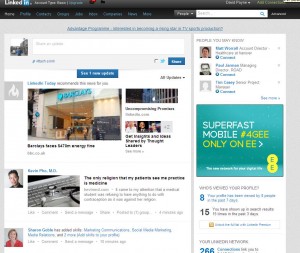David Payne: Top tips from Mr LinkedIn
1 Nov, 12 | by BMJ
In Copenhagen this week Richard Smith met Dr Twitter. In London I met Mr LinkedIn. Mark Williams (#mr_linkedin) describes himself as the UK’s leading independent LinkedIn trainer, helping individuals and organisations make the most of the professional network that now boasts 185m members worldwide, including 34,000 doctors at the last count. I went along to ask Williams, who was addressing an audience of publishers, why so many of my connections have started endorsing me lately. More about that later.
But first, some figures. Every second two people join LinkedIn, which was launched by Reid Hoffman in 2003 and is now a vibrant community where make connections, get business, undertake research, and join groups of likeminded professionals. More than half of its members live in the US. India is the second most popular country. It has 6m more members than the UK, but London is the most active city after San Francisco and New York, and Brazil is the fastest growing country.
As Williams reeled off these statistics to his audience of publishers I started to feel guilty that I don’t use LinkedIn more often (although people in the UK apparently use it more than in India). I’m one of 38,000 journalists on there, but I’ve never used it to find a job, research a story, or sell my services. Many of my BMJ Group colleagues working in sales and marketing, however, use it all the time. And today I was contacted by a US journalist who was interested in writing for the BMJ.
 Williams is good at explaining what LinkedIn isn’t. It’s not a communication tool, like Twitter. Unlike Facebook, it’s not a social network for friends and family. Neither is it possible to stalk somebody on LinkedIn. This reassured me, because I still feel intrusive when I check out someone’s profile for no apparent reason, as it’s hard to do that anonymously. And Mark said that the point of LinkedIn as a business network is to let you know when somebody has checked you out.
Williams is good at explaining what LinkedIn isn’t. It’s not a communication tool, like Twitter. Unlike Facebook, it’s not a social network for friends and family. Neither is it possible to stalk somebody on LinkedIn. This reassured me, because I still feel intrusive when I check out someone’s profile for no apparent reason, as it’s hard to do that anonymously. And Mark said that the point of LinkedIn as a business network is to let you know when somebody has checked you out.
I also realised it’s a mistake to see LinkedIn as a purely online network. Williams top “social selling” tip is to stop selling. “In a social meeting that’s the last thing you would do,” he said. Far better to make the connection (and ideally not with random strangers), build trust, and ideally talk on the phone or meet up.
He also advised against changing your profile picture too often, likening it to your corporate identify or brand logo (which most successful companies change rarely).
I currently have just one recommendation on LinkedIn, and I reciprocated immediately by recommending that person back. This is not good, says Williams, since it looks as if two friends have “done a deal” to recommend each other. Procrastination is LinkedIn’s enemy. You agree to recommend someone, and only get round to doing it last thing on a Friday, when nobody is looking. Far better to do it in the morning or at lunchtime.
And unlike TripAdvisor and Amazon recommendations, a LinkedIn recommendation can be from someone you know and whose opinion you trust. This makes it infinitely more valuable if you’re hiring someone’s services.
Williams described “endorsements” as a less credible version of recommendations, and an example of how the network mixed up terminology. It certainly boosts engagement on the site. When I first started receiving these a few weeks back, I started visting more often, which is probably what LinkedIn had in mind.
Finally, LinkedIn has more than a million groups, but almost all of them have engagement levels of around 2%. Growing memberhip and engagement levels is hard work. This is perhaps best illustrated by searching LinkedIn for doctor entrepreneurs (the subject of a separate blog by Richard Smith this week, who feels strongly that we need more of them.) Yes, there is a LinkedIn Group, but it has just five members.
David Payne is editor, bmj.com